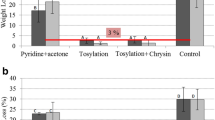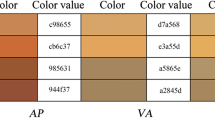Abstract
American beech (Fagus grandifolia) is an abundant, underutilized tree in certain areas of North America, and methods to increase its market value are of considerable interest. This research utilized pigment-producing fungi to induce color in American beech to potentially establish its use as a decorative wood. Wood samples were inoculated with Trametes versicolor, Xylaria polymorpha, Inonotus hispidus, and Arthrographis cuboidea to induce fungal pigmentation. Black pigmentation (T. versicolor, X. polymorpha, I. hispidus) was sporadic, occurred primarily on the surfaces of the heartwood, but not internally. Pink pigmentation (A. cuboidea) occurred throughout all of the tested beech samples, but was difficult to see in the heartwood due to the darker color of the wood. To increase the visibility of the pink stain, beech blocks were pretreated with T. versicolor for 4 weeks before being inoculated with A. cuboidea. This method significantly increased the saturation of the pink stain on both beech heartwood and sapwood, creating coloration similar to that found on sugar maple. This value-adding process should be particularly effective for small-scale wood pigmentation, and should help establish a market for this currently underutilized wood species.



Similar content being viewed by others
References
Anagnost SE, Worrall JJ, Wang CJK (1994) Diffuse cavity formation in soft rot of pine. Wood Sci Technol 28:199–208
Babitskaya VG, Shcherba VV (2002) The nature of melanin pigments of several micro- and macromycetes. Appl Biochem Micro 38(3):247–251
Blanchette RA, Wilmering AM, Baumeister M (1992) The use of green-stained wood caused by the fungus Chlorociboria in Intarsia masterpieces from the 15th century. Holzforschung 46(3):225–232
Bell Forest Products (2011) Online: http://www.bellforestproducts.com/. Accessed 8 March 2011
Boddy L (2000) Interspecific combative interactions between wood-decaying basidiomycetes. Fed Euro Microbiol Soc 31:185–194
Campbell AH (1933) Zone lines in plant tissues. 1. The black lines formed by Xylaria polymorpha (Pers.) grev. in hardwoods. Ann Appl Biol 20:123–145
Campbell RN (1959) Fungus sap-stains of hardwoods. Southern Lumberman 199(2489):115–20
Chidester MS (1940) A pink stain of wood caused by a species of Geotrichum. Phytopathology 30:530–533
Davidson RW (1935) Fungi causing stain in logs and lumber in the southern states, including five new species. J Agr Res 50(10):789–807
De Carvalho JC, Pandey A, Babitha S, Soccol CR (2003) Production of Monascus biopigments: an overview. Agro Food Ind Hi Tec 14:37–42
De Santis D, Moresi M, Gallo AM, Petruccioli M (2005) Assessment of the dyeing properties of pigments from Monascus purpureus. J Chem Technol Biot 80:1072–1079
Donovan G, Nicholls D (2003) Consumer preferences and willingness to pay for character-marked cabinets from Alaska birch. Forest Prod J 53(11/12):27–32
Dowding P (1969) The dispersal and survival of spores of fungi causing blue-stain in pine. Trans Br Mycol Soc 52(1):125–137
Dufossé L, Galaupa P, Yaronb A, Aradb SM, Blancc P, Murthyd KNC, Ravishankard GA (2005) Microorganisms and microalgae as sources of pigments for food use: a scientific oddity or an industrial reality? Trends Food Sci Tech 16:389–406
Durán N, Teixeira MFS, De Conti R, Esposito E (2002) Ecological-friendly pigment from fungi. Crit Rev Food Sci 42:53–66
Gibbs JN (1993) The biology of ophiostomatoid fungi causing sapstain in trees and freshly cut logs. In: Winfield MJ, Seifert KA, Webber JF (eds) Ceratocystis and Ophiostoma: taxonomy, ecology and pathogenicity. APS, St. Paul, pp 153–160
Golinski P, Krick TP, Blanchette RA, Mirocha CJ (1995) Chemical characterization of a red pigment (5,8-dihydroxy-2,7-dimethoxy-1,4-naphthalenedione) produced by Arthrographis cuboidea in pink stained wood. Holzforschung 49(5):407–410
Hedgcock GG (1906) Studies upon some chromogenic fungi which discolor wood. Missouri Botanical Garden Annual Report, pp 59–114
Heilmann-Clausen J, Boddy L (2005) Inhibition and stimulation effects in communities of wood decay fungi: exudates from colonized wood influence growth by other species. Microbial Ecol 49:399–406
Kozak RA, Cohen DH, Lerner J, Bull GQ (2004) Western Canadian consumer attitudes towards certified value-added wood products: an exploratory assessment. Forest Prod J 54(9):21–24
Loyalist Forest Products. 2011. Online: http://www.loyalistforest.com/?page=spalted_maple. Accessed: 8 March 2011
Lopez-Real JM, Swift MJ (1975) The formation of pseudosclerotia (‘zone lines’) in wood decayed by Armillaria mellea and Stereum hirsutum: II. Formation in relation to the moisture content of the wood. Trans Brit Mycol Soc 64(3):473–481
Mapari SAS, Nielsen KF, Larsen TO, Frisvad JC, Meer AS, Thrane U (2005) Exploring fungal biodiversity for the production of water-soluble pigments as potential natural food colorants. Curr Opin Biotech 16:231–238
Miller DJ, Goodell B (1981) Blue staining in ponderosa pine sapwood at moderate and low temperatures. Forest Prod J 31(2):54–59
Pandey KK (2005) A note on the influence of extractives on the photo-discoloration and photo-degradation of wood. Polym Degrad Stabil 87:375–379
Rayner ADM (1977) Interactions between fungi colonizing hardwood stumps and their role in determining patterns of colonization and succession. Ann Appl Biol 89:131–134
Rayner ADM, Boddy L (1978) Fungal communities in the decay of wood. Adv Microbiol Ecol 10:115–166
Rayner ADM, Todd NK (1978) Intraspecific antagonism in natural populations of wood-decaying basidiomycetes. J Gen Microbiol 103(6):85–90
Robinson SC (2011) Destroying uniformity: using fungi to add a tactile and visual experience to functional wood. Leonardo J 44(2):145–151
Robinson SC, Laks PE (2010a) Culture age and wood species affect zone line production of Xylaria polymorpha. Open Mycol J 4:18–21
Robinson SC, Laks PE (2010b) Wood species affects colonization rates of Chlorociboria sp. Int Biodeter Biodegr 64:305–308
Robinson SC, Laks PE (2011) The effects of copper in large scale mono- and dual-fungus wood systems. Forest Prod J 60(6):490–495
Robinson SC, Richter DL, Laks PE (2007a) Colonization of sugar maple by spalting fungi. Forest Prod J 57(4):24–32
Robinson SC, Laks PE, Richter DL, Pickens JB (2007b) Evaluating loss of machinability in spalted sugar maple. Forest Prod J 57(4):33–37
Robinson SC, Laks PE, Turnquist EJ (2009a) A method for digital color analysis of spalted wood using scion image software. Materials 2(1):62–75
Robinson SC, Richter DL, Laks PE (2009b) Effects of substrate on laboratory spalting of sugar maple. Holzforschung 63:491–495
Robinson SC, Tudor D, Cooper P (2011a) Wood preference by spalting fungi in urban hardwood species. International Biodeterioration and Biodegradation (in press)
Robinson SC, Tudor D, Cooper P (2011b) Feasibility of using red pigment producing fungi to stain wood for decorative applications. Can J Forest Res 41:1722–1728
Saikawa Y, Watanabe T, Hashimoto K, Nakata A (2000) Absolute configuration and tautomeric structure of xylindein, a blue-green pigment of Chlorociboria species. Phytochemistry 55:237–240
Sakaki T, Shibata M, Mukai K, Sakai M, Wakamatsu K, Miyauchi S (2002) Chlorociboria aeruginosa pigment as algicide. Jpn. Kokai Tokkyo Koho JP 2002291493
Scheffer TC, Lindgren RM (1940) Stains of sapwood and sapwood products and their control. US Dept Agr Tech. Bull No. 714, 124pp
Schmidt EL, Dietz MG (1985) Arthrographis cuboidea causing pink stain of sodium pentachlorophenoxide-treated red oak. Mycologia 77:316–318
Seifert KA (1993) Sapstain of commercial lumber by species of Ophiostoma and Ceratocystis. In: Wingfield MJ, Seifert KA, Webber JF (eds) Ceratocystis and Ophiostoma. Taxonomy, Ecology and Pathogenicity The American Phytopathological Society. 141–151
Sharland PR, Burton JL, Rayner ADM (1986) Mycelial dimorphism, interactions and pseudosclerotial plate formation in Hymenonchaete corrugata. Trans Br Mycol Soc 86:158–163
Sigler L, Yamaoka Y, Hiratsuka Y (1990) Taxonomy and chemistry of a new fungus from bark beetle infested Pinus contorta var. latifolia. Part 1. Arthrographis pinicola sp. nov. Can. J. Microbiol. 36:77–82
Stevens WC (1963) The transverse shrinkage of wood. For Prod J 13(9):386–389
Vesonder RF, Golinski P (1989) Metabolites of Fusarium. In: Chelkowski J (ed) Fusarium: mycotoxins, taxonomy and pathogenicity. Elsevier, Amsterdam, pp 1–39
Vlosky RP, Chance NP (2000) A timber resource assessment of Northwest Louisiana. Louisiana State University AgCenter Bulletin Number 873
Wheeler MH (1983) Comparisons of fungal melanin biosynthesis in ascomycetous, imperfect and basidiomycetous fungi. Trans Br Mycol Soc 81(1):29–36
Worrall JT, Anagnost SE, Zabel RA (1997) Comparison of wood decay among diverse lignicolous fungi. Mycologia 89(2):199–219
Zink P, Fengel D (1988) Studies of the colouring matter of blue-stain fungi. Part 1: general characterization and the associated compounds. Holzforschung 42(4):217–220
Author information
Authors and Affiliations
Corresponding author
Rights and permissions
About this article
Cite this article
Robinson, S.C., Tudor, D. & Cooper, P.A. Utilizing pigment-producing fungi to add commercial value to American beech (Fagus grandifolia). Appl Microbiol Biotechnol 93, 1041–1048 (2012). https://doi.org/10.1007/s00253-011-3576-9
Received:
Revised:
Accepted:
Published:
Issue Date:
DOI: https://doi.org/10.1007/s00253-011-3576-9




